How to Layout a Campsite: Choosing the Perfect Campsite
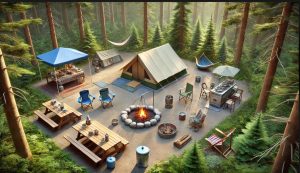
How do you build a perfect campsite? How to properly set up a campsite? How do you make a cool campsite? What is an ideal campsite? The Ultimate Guide to Set up A Perfect Campsite, How do you layout a campsite? How do you build a perfect campsite? Campground Layout Tips for the Ideal Camping Experience
Assess the Site
Selecting the right location is crucial for comfort and safety. Follow these tips:
- Survey the Terrain: Choose a flat, level area free from rocks, roots, and other hazards.
- Look for Wind and Sun Protection: Opt for a mix of shade and sun with natural windbreaks like trees or rocks.
- Distance from Water: Stay at least 200 feet (60 meters) away from water sources to prevent flooding and protect ecosystems.
- Check for Regulations: Some campsites have specific rules regarding fire use, waste disposal, and tent placement.
- Evaluate the Ground Surface: Soft, dry ground is best for sleeping comfort and tent stability.
Campground Layout Tips for the Ideal Camping Experience
Divide the Campsite into Zones
To maximize efficiency and comfort, organize your campsite into the following sections:
Sleeping Area
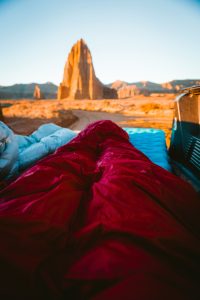
- Placement: Set up your tent on high ground to avoid water pooling.
- Setup Tips:
- Use a ground tarp for moisture protection.
- Avoid pitching under large tree branches.
- Securely stake down the tent.
- Orient your tent to face away from strong winds for better insulation and comfort.
- Use sleeping pads or inflatable mattresses for added comfort and warmth.
Cooking Area
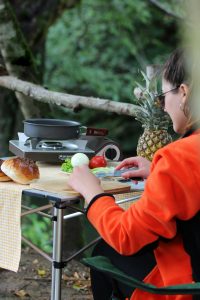
- Placement: Keep the cooking area at least 100 feet (30 meters) from the sleeping zone to reduce wildlife attraction.
- Setup Tips:
- Use a stable surface for your stove or grill.
- Store food in bear-proof containers or hang them from a tree.
- Keep a bucket of water or sand nearby for fire safety.
- Set up a windscreen if cooking in breezy conditions.
- Have designated storage for utensils and cooking gear to keep things organized.
Eating Area
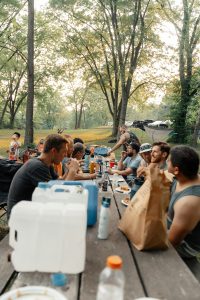
- Placement: Position the eating area near the cooking zone but away from tents.
- Setup Tips:
- Use a camping table for meal preparation.
- Dispose of food waste promptly to avoid attracting animals.
- Keep biodegradable soap and cleaning supplies handy for dishwashing.
- Set up shade protection using a tarp or canopy for comfortable dining.
Relaxation Area

- Placement: Arrange near the campfire (if permitted) or under shaded trees.
- Setup Tips:
- Position chairs in a semicircle for warmth and conversation.
- Use blankets, hammocks, or camping mats for comfort.
- Bring extra lighting, such as lanterns or string lights, to enhance ambiance.
- Consider setting up a separate space for reading, meditation, or stargazing.
Setting Up the Campfire Area
Campfire Placement & Safety
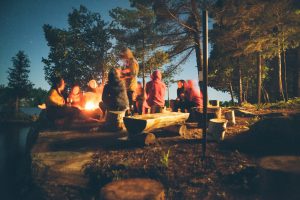
- Build fires away from tents, trees, and flammable objects.
- Use an existing fire ring or construct one with rocks.
- Keep firewood and tools at a safe distance.
- Fully extinguish the fire before leaving the site.
- Follow all fire regulations and guidelines for the area you’re camping in.
- Never leave a fire unattended.
Organizing Gear Storage
Gear Management Tips
- Keep Essentials Handy: Flashlights and first aid kits should be easily accessible.
- Separate Clean & Dirty Items: Use separate bags to stay organized.
- Protect Valuables: Store in a car or waterproof bag.
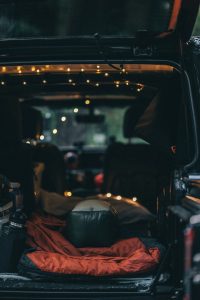
- Use Clear Bins or Labels: Helps quickly locate needed gear.
- Create a Drying Area: Hang wet clothes and towels to prevent mildew.
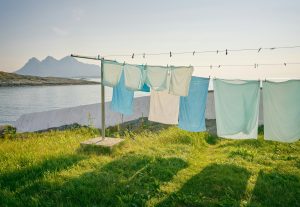
Ensuring Safety and Hygiene
Waste Management
- Set up a trash container at the campsite edge.
- Follow Leave No Trace principles—pack out all waste.
- Use separate bags for recyclables, compostable waste, and general trash.
- If allowed, use campsite-provided disposal facilities.
Bathroom Setup
- Choose a bathroom area at least 200 feet from water sources.
- Dig a cat hole (6-8 inches deep) for human waste.
- Bring biodegradable toilet paper and a small trowel.
- Use portable toilets if camping in a group setting for added convenience.
- Follow all campsite regulations regarding human waste disposal.
Insect Control
- Use repellents and mosquito nets as needed.
- Avoid leaving food or drinks uncovered, as they attract insects.
- Set up citronella candles or essential oil diffusers to deter bugs.
Personalizing and Adapting Your Campsite
Customize for Comfort
- Add string lights, a tarp for rain protection, or an outdoor rug.
- Adjust the layout based on weather, terrain, and group size.
- Consider setting up an entertainment area with games, books, or music.
- Bring comfortable seating options like reclining chairs or cushions.
Sample Campsite Layout
- Sleeping Zone: Tent on flat ground, slightly uphill.
- Cooking Zone: Camp stove and food storage downwind.
- Eating Zone: Folding table and chairs nearby.
- Relaxation Zone: Hammock and camp chairs around the fire pit.
- Gear Storage Zone: Organized area for keeping essentials dry and accessible.
Final Tips for a Perfect Campsite
- Plan your layout before unpacking.
- Keep the site tidy to minimize environmental impact.
- Follow campsite regulations and Leave No Trace principles.
- Be mindful of weather changes and adjust your setup accordingly.
- Double-check for personal belongings before leaving to ensure nothing is left behind.
By implementing these campground layout tips, you’ll create a comfortable, safe, and efficient campsite for an enjoyable outdoor experience.
1. Tents and Sleeping Gear
When selecting the perfect tent, make sure it fits your needs for size and comfort. Use a ground tarp to protect your tent from moisture and enhance sleeping comfort with a sleeping pad or inflatable mattress.
2. Camping Furniture & Storage Solutions
To maximize comfort, invest in sturdy camping furniture like portable chairs and tables. For organized storage, look for options that keep your gear dry and accessible, such as clear bins or labeled bags.
3. Cooking Gear & Cooking Area Setup
Keep your cooking area efficient by using a stable surface for your camping stove or grill. Ensure safety with proper fire safety tools and store your food in bear-proof containers to prevent wildlife attraction.
4. Campfire Setup and Safety
A safe and controlled campfire is essential for creating a cozy environment. Build your fire in an existing fire ring or construct one with rocks, and always have a fire extinguisher or sand nearby to stay safe.
5. Lighting & Relaxation Gear
For a cozy campsite, set up outdoor lighting like lanterns or string lights to create an inviting atmosphere. Consider adding a hammock or comfortable seating for relaxation by the fire.
Want to discover the best way to illuminate your camp? Experts dish on our favorite lanterns in the REI Lantern Gear Guide. Learn about lumens, burn time and extra features to decide which camping lantern is the right fit for your next adventure. Find out on this Youtube video
6. Insect Control & Hygiene
Protect yourself from insects by using effective mosquito nets and insect repellents. Keep food covered and use citronella candles or diffusers to keep bugs at bay.
7. Portable Toilets & Waste Disposal
If camping in a group or without access to facilities, consider using portable toilets for added convenience. Always follow proper waste disposal guidelines to keep your campsite clean and eco-friendly.
Look out our other article about what is the best age to start camping with a child?
Leave a Reply